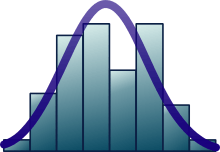Glossary of probability and statistics
The following is a glossary of terms used in the mathematical sciences statistics and probability.
| Statistics |
|---|
 |
|
| Probability |
|---|
 |
A
B
C
D
E
F
J
K
L
M
N
P
R
S
T
U
V
Z
gollark: You know what would be cool? Dynamically generate new API versions for no reason.
gollark: Well, yes, that's basically what I'm talking about - you can use genders to reference three or so at once.
gollark: Or to have a convenient short way to say "the noun I said 3rd most recently" or somethin.
gollark: Possibly more useful would be the ability to temporarily assign nouns to "variables" or something in a language, and then reference those in place of a noun.
gollark: no.
See also
References
- Reiter, Jerome (January 24, 2000). "Using Statistics to Determine Causal Relationships". American Mathematical Monthly. 107 (1): 24–32. doi:10.2307/2589374. JSTOR 2589374.
- Pav Kalinowski. Understanding Confidence Intervals (CIs) and Effect Size Estimation. Association for Psychological Science Observer April 10, 2010. http://www.psychologicalscience.org/index.php/publications/observer/2010/april-10/understanding-confidence-intervals-cis-and-effect-size-estimation.html
- Moore, David; McCabe, George (2003). Introduction to the Practice of Statistics (4 ed.). New York: W.H. Freeman and Co. p. 438. ISBN 9780716796572.
External links
- "A Glossary of DOE Terminology", NIST/SEMATECH e-Handbook of Statistical Methods, NIST, retrieved 28 February 2009
- Statistical glossary, statistics.com, retrieved 28 February 2009
- Probability and Statistics on the Earliest Uses Pages (Univ. of Southampton)
This article is issued from Wikipedia. The text is licensed under Creative Commons - Attribution - Sharealike. Additional terms may apply for the media files.